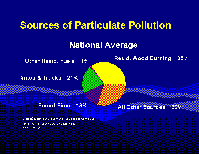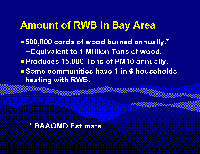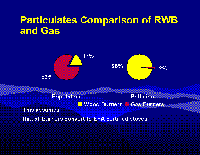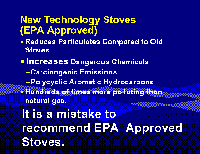Education Menu
![]()
Go to Part 1 Part
3 Part 4 Part
5
 Notice from this EPA data
that the most significant sources of particulate pollution are
RWB and motor vehicles. Note how little comes from other residential
heating sources.
Notice from this EPA data
that the most significant sources of particulate pollution are
RWB and motor vehicles. Note how little comes from other residential
heating sources.
 A surprising variety of
harmful matter is present in wood smoke in addition to particles.
Most people now acknowledge that secondary cigarette smoke is
bad because it contains so many of these materials, but don't
seem to make the leap to realize that the same pollutants are
in wood smoke and that wood smoke is also bad. In fact, the free
radicals in wood smoke remain chemically active in the body 40
times longer than the free radicals in cigarette smoke.
A surprising variety of
harmful matter is present in wood smoke in addition to particles.
Most people now acknowledge that secondary cigarette smoke is
bad because it contains so many of these materials, but don't
seem to make the leap to realize that the same pollutants are
in wood smoke and that wood smoke is also bad. In fact, the free
radicals in wood smoke remain chemically active in the body 40
times longer than the free radicals in cigarette smoke.
 A huge amount of wood is
burned in the warm climate of the San Francisco Bay. These numbers
come from a telephone survey made by the BAAQMD. The corresponding
amount of PM10 generated is 17 thousand tons. (Think of it - 17
thousand tons of particles no larger than a red blood cell!)
A huge amount of wood is
burned in the warm climate of the San Francisco Bay. These numbers
come from a telephone survey made by the BAAQMD. The corresponding
amount of PM10 generated is 17 thousand tons. (Think of it - 17
thousand tons of particles no larger than a red blood cell!)
 In many areas the problem
of RWB is exacerbated by inversion layers. This is true in the
Bay Area where on a typical clear winter evening the inversion
layer starts to form at about 4 PM and stays in place at 80 -
100 foot elevation until the early morning, trapping all air pollutants
close to the ground.
In many areas the problem
of RWB is exacerbated by inversion layers. This is true in the
Bay Area where on a typical clear winter evening the inversion
layer starts to form at about 4 PM and stays in place at 80 -
100 foot elevation until the early morning, trapping all air pollutants
close to the ground.
 About 12 percent of your
neighbors generate 98 percent of the home heatining particulate
pollution.
About 12 percent of your
neighbors generate 98 percent of the home heatining particulate
pollution.
 There has been a lot of
favorable publicity given to EPA-approved stoves. These stoves
are seen as the great hope of those people who wish to burn. The
hope is misguided. The stoves are still hundreds of times more
polluting than natural gas, propane or oil. The only answer
is to stop RWB .
There has been a lot of
favorable publicity given to EPA-approved stoves. These stoves
are seen as the great hope of those people who wish to burn. The
hope is misguided. The stoves are still hundreds of times more
polluting than natural gas, propane or oil. The only answer
is to stop RWB .
NEXT
